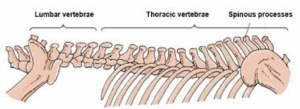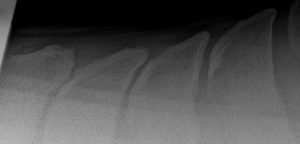Kissing Spines – could your horse be suffering in silence?
What are kissing spines?
The horse is often suffering due to chronic pain associated with the dorsal spinous processes of the thoracic spine. This is usually because the bony processes are close together, often rubbing together and sometimes overriding one another. This causes pain due to the bone and associated ligament inflammation.
They are relatively common, with research showing that 34% of horses have evidence of kissing spines on x-rays, although many will not be showing symptoms.
We generally see them in eventers and dressage horses. This may be because subtle pain is more noticeable in these horses when they are put under pressure to perform, or that competition horses are more susceptible due to the additional pressure when working.

A horse’s spinal column. The thoracic vertebrae are those attached to ribs. The spinous processes protrude dorsally (upwards) from the spine. It is these that can become close or overriding.
What symptoms do we see?
Horses are usually presented to us due to poor performance or behaviour. These may include struggling to maintain canter and becoming disunited frequently; less accepting of the bit, and lameness. Riders may also report a “cold-backed” horse that resents having the saddle placed.
How do we diagnose kissing spines?
We take time to perform a detailed clinical examination, including at rest, when trotted up on different surfaces (including lungeing), and often observing the horse ridden. We look for a suggestion the horse is struggling to engage his hindquarters, struggling with canter and observe his facial expressions.
Following clinical exam, we generally recommend radiography (x-rays) to confirm our suspicions and guide appropriate treatment. We may also recommend local infiltration of local anaesthetic (essentially a nerve block) to confirm the diagnosis. We sometimes also perform ultrasonography of the region to add another piece to the puzzle.

Radiograph (X-Ray) of the very top of a horse’s dorsal spinous processes in the thoracic spine
How do we treat kissing spines?
It is dependent on the individual horse, and the horse’s discipline. Some horses have higher tolerance levels than others, and there is a variation in the degree of impingement caused by close or overriding spinous processes.
We may suggest local medication with corticosteroids (with or without other drugs) which aim to reduce the inflammation and pain in the area, followed by physiotherapy. Physiotherapy is of huge benefit in horses with kissing spines, and often removes the need for surgery. Dr Steve Brooks regularly performs deep tissue massage and manipulation of horses with spinal pain. We may give you exercises to perform with your horse to improve his core stability and flexibility.
We do sometimes recommend surgery in these cases. Deciding whether or not surgery is appropriate isn’t often clear cut, and we usually discuss these cases at length with specialist surgeons to decide on the best course of action. There are 2 surgeries most commonly performed – one involves cutting the ligament that joins the spinous ligaments together (Interspinous Ligament Desmotomy), this is done standing under sedation and local nerve blocks. These horses can be back in work as soon as 6 weeks later. The second surgical option involves removing sections of bone to ensure they do not override eachother, this is more commonly done standing now under sedation, but may in some cases require general anaesthesia (as was originally done in the 1980s when the procedure first came about). These horses require a much longer recovery and rehab period.
If you have any concerns your horse may be suffering with kissing spines, please do not hesitate to get in touch with one of our friendly vets. You can contact us via the office on 01737 246109, or by email at admin@gvgbrooksequine.co.uk
